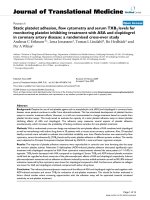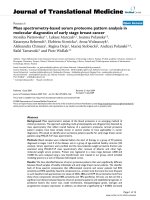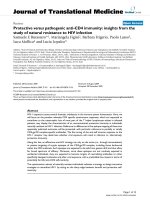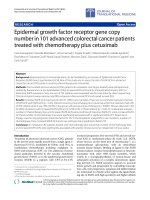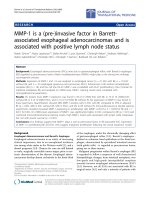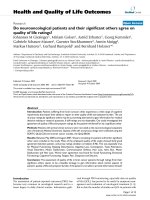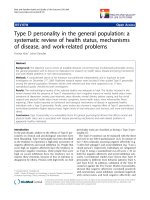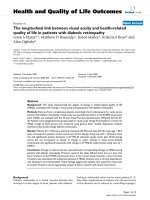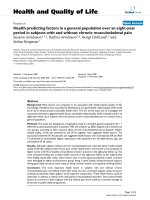báo cáo hóa học: " Insulin-like growth factor-I peptides act centrally to decrease depression-like behavior of mice treated intraperitoneally with lipopolysaccharide" ppt
Bạn đang xem bản rút gọn của tài liệu. Xem và tải ngay bản đầy đủ của tài liệu tại đây (1.37 MB, 38 trang )
This Provisional PDF corresponds to the article as it appeared upon acceptance. Fully formatted
PDF and full text (HTML) versions will be made available soon.
Insulin-like growth factor-I peptides act centrally to decrease depression-like
behavior of mice treated intraperitoneally with lipopolysaccharide
Journal of Neuroinflammation 2011, 8:179 doi:10.1186/1742-2094-8-179
Sook-Eun Park ()
Marcus Lawson ()
Robert Dantzer ()
Keith W Kelley ()
Robert H McCusker ()
ISSN 1742-2094
Article type Research
Submission date 25 August 2011
Acceptance date 21 December 2011
Publication date 21 December 2011
Article URL />This peer-reviewed article was published immediately upon acceptance. It can be downloaded,
printed and distributed freely for any purposes (see copyright notice below).
Articles in JNI are listed in PubMed and archived at PubMed Central.
For information about publishing your research in JNI or any BioMed Central journal, go to
/>For information about other BioMed Central publications go to
/>Journal of Neuroinflammation
© 2011 Park et al. ; licensee BioMed Central Ltd.
This is an open access article distributed under the terms of the Creative Commons Attribution License ( />which permits unrestricted use, distribution, and reproduction in any medium, provided the original work is properly cited.
1
Insulin-like growth factor-I peptides act centrally
to decrease depression-like behavior of mice
treated intraperitoneally with lipopolysaccharide
Sook-Eun Park
1,2,4
, Marcus Lawson
1,2,3
,
Robert Dantzer
1,2,3,4
, Keith W. Kelley
1,2,3,4
and Robert H. M
c
Cusker
1,2,3,4
Integrated Immunology and Behavior Program
1
University of Illinois at Urbana-Champaign
Urbana, Illinois 61801-3873, USA,
Neuroscience Program
2
University of Illinois at Urbana-Champaign
Urbana, Illinois 61801-3873, USA,
Department of Animal Sciences
3
University of Illinois at Urbana-Champaign
Urbana, Illinois 61801-3873, USA,
and
Department of Pathology
4
,
University of Illinois at Urbana-Champaign
Urbana, Illinois 61801-3873, USA
Address all correspondence to: Robert H. M
c
Cusker, Ph.D.
250A Edward R. Madigan Laboratory, MC-051
1201 W. Gregory Dr.
Urbana, IL 61801-3873, USA
e-mail:
Tel: (217) 333-5142
Fax: (217) 244-5617
2
Abstract
Centrally administered insulin-like growth factor (IGF)-I has anti-depressant activity in
several rodent models, including lipopolysaccharide (LPS)-induced depression. In this study we
tested the ability of IGF-I and GPE (the N-terminal tri-peptide derived from IGF-I) to alter
depression-like behavior induced by intraperitoneal (i.p.) administration of LPS in a preventive
and curative manner. In the first case, IGF-I (1 µg) or GPE (5 µg) was administered i.c.v. to CD-
1 mice followed 30 min later by 330 µg/kg body weight i.p. LPS. In the second case, 830 µg/kg
body weight LPS was given 24 h prior to either IGF-I or GPE. When administered i.p., LPS
induced full-blown sickness assessed as a loss of body weight, decrease in food intake and
sickness behavior. None of these indices were affected by IGF-I or GPE. LPS also induced
depression-like behavior; assessed as an increased duration of immobility in the tail suspension
and forced swim tests. When administered before or after LPS, IGF-I and GPE abrogated the
LPS response; attenuating induction of depression-like behaviors and blocking preexistent
depression-like behaviors. Similar to previous work with IGF-I, GPE decreased brain expression
of cytokines in response to LPS although unlike IGF-I, GPE did not induce the expression of
brain-derived neurotrophic factor (BDNF). LPS induced expression of tryptophan dioxygenases,
IDO1, IDO2 and TDO2, but expression of these enzymes was not altered by GPE. Thus, both
IGF-I and GPE elicit specific improvement in depression-like behavior independent of sickness,
an action that could be due to their anti-inflammatory properties.
Keywords: IGF-I, depression-like behavior, sickness, lipopolysaccharide
3
Background
There is accumulating evidence that depression may develop in response to activation
of the innate immune system [1-3]. Exposure of volunteers to a low dose of endotoxin induces
depressed mood that correlated with cytokine expression, independent of sickness behaviors [4].
Recently, a low dose of endotoxin given to volunteers was for the first time shown to induce
anhedonia, one of the primary features (diagnostic = DSM IV) for depression [5]. An increase in
negative affect follows typhoid vaccine injections and similar to endotoxin exposure, these mood
changes correlate with the induction of cytokine secretion [6]. Studies such as these provide a
correlation between mood changes and inflammation, but a direct cause-effect link between
activation of the innate immune system and mood changes came with human cytokine
immunotherapy. Cancer immunotherapy and cytokine treatment for hepatitis C viral infection
induces symptoms of depression in a significant percentage of patients [7, 8]. These symptoms
develop on a background of neurovegetative symptoms that are very similar to inflammation-
induced sickness behavior [3]. Together with the Reichenberg study [4] showing a dissociation
between depression and overt sickness, there is now strong evidence that depression does not
fully overlap with sickness and that depression may be caused by cytokines in the brain.
In a rodent preclinical model, activation of the immune system reliably induces
depression-like behavior assessed by several criteria including decreased preference for a
sweetened (saccharin) solution over water, as an index of anhedonia, decreased sexual
behavior [9], decreased preference for a sweetened (sucrose) solution over water, increased
time of immobility during the forced swim test (FST) [10] and increased time of immobility during
the tail suspension test (TST) [11]. LPS induces transient sickness with the changes in
preference for a sweetened solution or immobility in the FST and TST still being evident after
the disappearance of sickness; i.e. after locomotor activity, social exploration of a novel juvenile,
body weight or food intake have normalized. These depression-like behaviors are reversed by
4
anti-depressants and importantly by minocycline which attenuates LPS-induced expression of
brain cytokines [9, 11-14]. In all of these studies, depression-like behaviors continued after the
acute immune response that was induced by LPS and the minocycline study clearly indicated
that the cytokine response was requisite for the development of depression-like behaviors.
These types of studies support the human data that inflammation is causative in the
development or maintenance of depressive disorders.
Until recently, IGF-I has not been evaluated for anti-depression actions on a background
of inflammation. We showed that i.c.v. IGF-I did not affect the acute sickness response that was
induced by i.c.v. LPS. In contrast, IGF-I tempered cytokine expression and depression-like
behavior [11]. In that study, IGF-I also increased the central expression of BDNF, a neurotrophin
with well-characterized anti-depressant activity. For that work, gene expression was quantified
in cDNA prepared from the entire perfused brain of mice [11, 13]. Whether, the LPS or IGF-I
responses were global or localized with a specific brain region was not examined. However,
following a single LPS injection, pro-inflammatory cytokines, IL-1β, TNFα and IL-6 are all
similarly elevated in the hippocampus and frontal cortex of mice [15]. Following repeated LPS
injections, IL-1β is elevated in the frontal cortex, hippocampus and striatum [16]. These studies
suggest that LPS induces a global inflammatory response within the brain and justified our
previous use of total brain mRNA as the source for cDNA to quantify an immune response
following LPS. However, it is clear from studies with humans that the frontal cortex plays a
unique role in depression [17-20]. Similarly with rodents, electrical stimulation of the frontal
cortex elicits hedonic vocalizations [21], whereas lesions reduce play behavior [22]. The
antidepressant effect of fluoxetine on immobility in the TST was shown to correlate with BDNF
expression in the frontal cortex, but not in the hippocampus [23] implicating a unique role for the
frontal cortex in depression-like behavior of mice. Thus in the current study, expression of genes
associated with inflammation were quantified in the frontal cortex of mice.
5
IGF-I is well recognized as a neuroprotective hormone and paracrine growth factor
displaying activities in a variety of neuropathologies [24, 25]. IGF-I is cleaved within the brain to
release an N-terminal tripeptide [26]. GPE, like IGF-I, is neuroprotective both in vivo and in vitro
[27]. Lower amounts of GPE provide protection when given i.c.v. compared to i.p. suggesting a
central site of action; indeed GPE does not appear to act outside the nervous system. Thus
GPE may represent a centrally active IGF-derivative, separating it from the global role of IGF-I.
Importantly, purification of IGF-I from brain yields IGF-I lacking the first 3 amino acids [26, 28,
29] suggesting that GPE is naturally produced in the brain. Indeed, GPE is found in the normal
brain [30] and a protease that releases GPE is found in brain [31, 32]. Protease inhibitors, that
prevent the release of GPE from IGF-I, block IGF-I inhibition of GNRH secretion [33, 34]. This
later finding strongly suggests that GPE mediates at least part of the central action of IGF-I.
These finding suggest that GPE is a natural product of central IGF-I and has naturalistic
neuroprotective actions. A central function for GPE, outside of cell survival such as behavior
modification, has not been reported. The current study shows that like IGF-I its’ natural cleaved
product, GPE, has behavior modifying activity. In the present series of experiments, we show
that both IGF-I and GPE administered centrally are able to prevent and cure depression-like
behavior induced by peripheral administration of LPS.
6
Methods
Animals
Male CD-1 mice, 7 to 8 weeks old, were purchased from Charles River Laboratory
International, Inc. (Wilmington, MA). Mice were group housed in ventilated cages under a 12:12
h reversed light:dark cycle (lights off at 10:00 h) for 2 weeks until surgery. Juvenile, 3 to 4 wk of
age, C57BL/6J mice were used as novel targets for tests of social exploration. Food and water
was provided ad libitum. Animal care and procedures were conducted with the approval of the
University of Illinois’ Institutional Animal Care and Use Committee.
Surgery
Mice were anesthetized with ketamine (100 mg/kg body weight) and xylazine (10 mg/kg
body weight). Pain was attenuated using buprenorphine (0.05 mg/kg body weight) given prior to
surgery. Mice were secured in a stereotaxic instrument (David Kopf Instruments, Tujunga, CA).
Stainless-steel guide cannulae (26-gauge, Plastics One Inc., Roanoke, VA) were implanted
above the lateral ventricle; 0.6 mm posterior and 1.3 mm lateral to the bregma. The guide
cannulae extended 1.3 mm below the skull. Cannulae were secured with “cold cure” Teets
denture mixture (Co-oral-lte Dental MFG Co, Diamond springs, CA). Mice were individually
housed post-surgery in conventional cages with a 2-week recovery period before treatment.
Treatments
Mice were handled for at least 5 days prior to transfer to a room in the behavioral suite
2-3 days before treatment. A white noise Marpac soundscreen was used to minimize
interference from external sounds while in the behavior suite. Experimental mice were 11 to 12
weeks of age at treatment. All treatments were administered at the end of light phase. IGF-I
(recombinant human, GroPep, Adelaide, Australia) was prepared at 1 µg/µl, GPE was prepared
at 5 µg/µl and LPS (serotype 0127:B8, Sigma, St. Louis, MO) at 33 or 83 µg/ml. IGF-I, GPE or 1
µl PBS were administered, injection time approximately 1 min, through the guide cannula and
7
into the lateral cerebral ventricle using a 33-gauge stainless-steel cannula. Therefore, the final
dose of IGF-I was 1 µg, which we have previously shown to be active i.c.v. [11], and the final
dose of GPE was 5 µg, which is within the range tested i.c.v. for neuroprotection [35, 36]. LPS
was administered i.p. at 10 ml/kg body weight for final doses of 330 or 830 µg/kg body weight.
We have previously shown that the higher dose of LPS causes depression-like behavior for at
least 24 h assessed using either the forced swim, tail suspension or sucrose preference tests,
while locomotor activity is expected to return to normal [10]. The low dose of LPS was
determined empirically as a dose that elicits depressive-like behavior after a short acute-phase
sickness response. At 330 µg/kg LPS body weight, mice do not present with either sickness or
depression-like behaviors at 24 h (data not shown). IGF-I, GPE or PBS were administered
either 30 min prior to 330 µg/kg LPS or PBS or they were administered 24 h after 830 µg/kg
LPS. Treatment combinations are: PBS/PBS (Control), IGF-I or GPE/PBS (IGF-I or GPE),
PBS/LPS (LPS) and IGF-I or GPE/LPS (IGF-I + LPS or GPE + LPS). LPS, at 830 µg/kg body
weight, induces depression-like behavior that lasts at least 30 h. This time interval presents
ample opportunity for IGF-I/GPE administration to be given post- LPS (at 24 h) while still
permitting assessment of depression-like behavior. LPS, at 330 µg/kg body weight induces a
less intense and more transient sickness response permitting the evaluation of an IGF-I/GPE
effect on the development of depression-like behavior.
Sickness response
Body weight and food weight were recorded before treatment and at various intervals
post treatment. Sickness associated with LPS administration parallels a loss of body weight and
decreased food intake. Social exploration of novel C57BL/6J juvenile mice and general
locomotor activity were used to assess sickness behavior. Social investigation was performed
with protected juveniles; juveniles confined to a 8 x 8 x 11.5 cm wire cage and placed in the
corner of the experimental mouse’s home cage [11]. Time spent by the experimental mouse
exploring the caged juvenile during the 5 min test interval was recorded by a trained person
8
blind to treatment. Social exploration was performed 24 h prior to treatment (baseline), then 2
and 6 h after treatment, using a different juvenile at each time point. Social exploration was
used to assess recovery rate during the acute phase of sickness; 2-6 h after LPS administration
because it can be administered repeatedly without habituation by the test subject. Locomotor
activity (LMA) was recorded by a trained person blind to treatment from 5 min recording of mice
placed in a clean cage and was only performed once for each experimental mouse 27 h after
treatment with LPS. We use this test to determine the degree of residual sickness behavior
when testing for depression-like behavior at a single time point usually 24 to 30 h following LPS.
This test was used in lieu of social exploration because of its simplicity. LMA cannot be used to
assess rate of recovery during the acute phase of sickness as it can only be performed once per
mouse, due to habituation. LMA was assessed as the number of cage quadrants entered during
the test period. All behavioral assessments were performed under red light illumination during
the dark phase of the light cycle.
Depression-like behavior
Depression-like behavior was measured as duration of immobility in the FST or TST and
preference for consumption of a sweetened solution (sucrose preference). The TST was
performed as previously described [11] using the Mouse Tail Suspension Package (MED-TSS-
MS; Med Associates, St Albans, VT) 9 h after treatment with LPS. Adhesive tape was attached
to each mouse’s tail for suspension from a strain gauge. Force from the mouse’s struggle was
recorded during a 10 min session. Mice were considered immobile when force was below the
lower threshold. The FST was performed as previously described [13] 30 h after treatment with
LPS. Mice were recorded for 6 min and immobility recorded by a trained person blind to
treatment. Sucrose preference was performed by quantifying disappearance of liquid (change in
weight) from bottles containing either water or water containing 1 % sucrose (wt. / vol.).
Preference was calculated as disappearance of the sucrose solution / disappearance of total
fluid (water + sucrose). Four hour sucrose preference was measured from 12 noon to 4 pm.
9
Animals were trained for 3 days prior to treatment; then preference was assessed on the same
day as LPS treatment (4 h post-treatment) and the following day (4 h post-treatment with GPE) .
Tissue preparation for real time PCR
Immediately after assessment of behavior, mice were euthanized with CO
2
then they
were transcardially perfused with cold PBS. Brains were excised, dissected and frozen on dry
ice. The frontal cortex, containing the frontal association, dorsolateral orbital, ventral orbital and
prelimbic cortices (first 1 mm of the frontal cortex as defined in The Mouse Brain [37]), was
collected and stored at -80 °C until solubilized with TRIzol (Invitrogen Life Technologies,
Carlsbad, CA) and RNA prepared as described [11]. RNA was quantified using a Nanodrop ND-
1000 spectrophotometer (Nanodrop Technologies, Inc. Wilmington, DE). RNA was reverse
transcribed using High Capacity cDNA Reverse Transcription Kits (catalog no. 4368813,
Applied Biosystems, Foster city, CA) to prepare cDNA. Real-time rtPCR was performed to
quantify steady-state mRNA as described previously [11]. Assays were purchased from Applied
Biosystems (Foster City, CA) and amplification performed with a Prism 7900 (Applied
Biosystems) and the TaqMan universal PCR master mix (Applied Biosystems, catalog no.
4305719). A 50 ng aliquot of cDNA was used per reaction. GAPDH was used to normalize
target gene expression. Expression of GAPDH was not affected by any of the treatment
combinations (data not shown). Changes in gene expression are expressed as 2
-∆∆Cts
, where Ct
is the cycle threshold. A brief description of the target genes and primers has been presented
[11].
Statistical analysis
All data were expressed as mean ± SEM; Data were analyzed by a two-way (IGF-I x
LPS) ANOVA using StatView (SAS Institute Inc., San Francisco, CA) or SigmaPlot (Systat
Software, Inc., San Jose, CA). Where appropriate (social investigation, changes in body weight
and food intake), data were analyzed using repeated measures ANOVA. SigmaPlot was used
10
for the preparation of figures. Tukey’s HSD (Honestly Significant Difference) was used for post
hoc analysis when a significant interaction was present.
11
Results
IGF-I does not prevent LPS-induced sickness, but attenuates depression-like behavior
To assess its ability to prevent LPS-induced depression-like behavior, IGF-I was
administered i.c.v. 30 min prior to LPS and several assessments were made to quantify
sickness and depression-like responses. To investigate the effect of i.c.v. IGF-I on sickness,
changes in body weight, food intake and social exploration towards a novel juvenile were
assessed (Fig. 1). As expected, LPS administration at 330 µg/kg body weight i.p. caused
sickness, p < 0.05 evident by all measures. Mice treated with LPS lost body weight (Fig. 1A),
ate less food (Fig. 1B) and spent less time exploring a novel juvenile mouse (Fig. 1C). Mice
were recovering between 6 and 9 h post-LPS for all three indices, although less-so for food
intake. These are typical responses for this low dose of LPS. Administration of IGF-I i.c.v. did
not alter the ability of LPS to induce sickness, being without effect on body weight, food intake
and social explorations, p > 0.05. Depression-like behavior was assessed by duration of
immobility during the tail suspension test (Fig. 1D). Duration of immobility was increased by LPS
(p < 0.05) and decreased by IGF-I (p < 0.05). The interaction between the two treatments was
significant [F (1,80) = 4.9, p < 0.05]. Post-hoc analysis revealed that duration of immobility did
not differ between controls and mice treated with IGF-I, although time spent immobile by mice
treated with IGF-I + LPS was still above that of controls or IGF-I, p < 0.05; thus IGF-I did not
completely block LPS-induced depression-like behavior. Duration of immobility was highest in
mice treated with LPS and was significantly different from that of all other groups, p < 0.05.
Thus, similar to our previous work administering both IGF-I and LPS i.c.v. [11], i.c.v. IGF-I has
anti-depression like activity, but not anti-sickness activity against i.p. administered LPS.
12
IGF-I does not affect preexisting LPS-induced sickness, but alleviates LPS-induced
depression-like behavior
To assess its ability to cure LPS-induced depression-like behavior, IGF-I was
administered i.c.v. 24 h after i.p. LPS (when sickness behavior was expected to be mild or
absent; thereby testing for an antidepressant activity of IGF-I following acute sickness). As in
the prevention model, several assessments were made to quantify sickness and depression-like
responses. As expected, LPS administration at 830 µg/kg body weight i.p. caused sickness, p <
0.05 evident by all measures. Mice treated with LPS lost body weight (Fig. 2A), ate less food
(Fig. 2B). At 27 h, LPS-treated mice still had residual albeit mild sickness evident as lower
spontaneous movement in a clean cage compared to controls: locomotor activity (Fig. 2C).
These are typical responses for this higher dose of LPS. Administration of IGF-I i.c.v. did not
alleviate the changes induced by LPS during the 6 h time interval (24-30 h); IGF-I being without
effect on body weight, food intake and locomotor activity, p > 0.05. Depression-like behavior
was assessed by duration of immobility during the forced swim test (Fig. 2D). Duration of
immobility was elevated by LPS and this elevation in depression-like behavior was reversed by
IGF-I with a significant interaction between the two treatments [F (1,21) = 5.5, p < 0.05]. Post-
hoc analysis revealed that immobility did not differ between controls, mice treated with IGF-I, or
mice treated with both IGF-I + LPS, p > 0.05. In contrast, immobility was highest in mice treated
with LPS and was significantly different from all other groups, p < 0.05. Again, IGF-I had anti-
depression, but not anti-sickness activity.
GPE does not prevent LPS-induced sickness, but attenuates depression-like behavior
To assess its ability to prevent LPS-induced depression-like behavior, GPE was
administered i.c.v. 30 min prior to LPS to quantify sickness and depression-like responses. LPS
administration i.p. caused sickness again evident by all measures, p < 0.05: mice treated with
LPS lost body weight (Fig. 3A), ate less food (Fig. 3B) and spent less time exploring a novel
13
juvenile mouse (Fig. 3C). Mice recovered between 6 and 9 h post-LPS for all three indices.
Administration of GPE i.c.v. did not alter the ability of LPS to induce sickness, being without
effect on body weight, food intake and social explorations, p > 0.05. Depression-like behavior
was assessed by duration of immobility during the tail suspension test (Fig. 3D). Immobility was
elevated by LPS (p < 0.05) and reduced by GPE (p < 0.05) although the interaction between the
two treatments did not reach significance. These changes show that GPE has anti-depression
like activity, but not anti-sickness activity.
GPE does not affect preexisting LPS-induced sickness, but alleviates LPS-induced
depression-like behavior
To assess its ability to cure LPS-induced depression-like behavior, GPE was
administered i.c.v. 24 h after i.p. LPS. As described above, LPS administration at 830 µg/kg
body weight i.p. caused sickness, p < 0.05 evident by all measures: mice treated with LPS lost
body weight (Fig. 4A), ate less food (Fig. 4B) and had lower spontaneous movement in a novel
clean cage: locomotor activity (Fig. 4C). Administration of GPE i.c.v. did not alleviate the
changes induced by LPS; GPE being without effect on body weight or food intake during the 6 h
time interval (24-30 h). GPE decreased locomotor activity, p < 0.05; without a significant LPS x
GPE interaction, p > 0.05. Depression-like behavior was assessed by duration of immobility
during the FST (Fig. 4D). Duration of immobility was elevated by LPS. GPE had no effect on its
own, on the duration of immobility during the FST, but there was a significant interaction
between the effects of LPS and GPE [F (1,19) = 8.5, p < 0.05]. Post-hoc analysis revealed that
immobility did not differ between controls, mice treated with GPE, or mice treated with both GPE
+ LPS, p > 0.05. In contrast, duration of immobility was highest in mice treated with LPS and
significantly different from controls or mice treated with GPE plus LPS, p < 0.05. Again, GPE
had anti-depression activity. In contrast to these findings, GPE was unable to reverse the
decrease in sucrose preference observed following LPS administration. As shown in Figure 4E,
14
sucrose preference was stable for the two days prior to treatment for all treatment groups. LPS
caused a decrease in sucrose preference during the 4 to 8 h interval after treatment. Sucrose
preference was still depressed for LPS-treated mice when assessed 28 to 32 h after treatment.
GPE, given 24 h after LPS, did not alter sucrose preference 4 to 8 h later (28 to 32 h post-LPS).
GPE administered i.c.v. decreases i.p. LPS-induced expression of brain cytokines
LPS-induced changes in behavior are dependent on the induction of brain pro-
inflammatory cytokines. We had previously shown that IGF-I diminishes expression of brain
cytokines [11]; a possible mechanism to alleviate depression-like activity. Thus the ability of
GPE to alter the expression of inflammatory factors within the frontal cortex was examined. LPS
(Fig. 5) significantly (p < 0.05) increased mRNA expression of IL-1β and TNFα (Fig. 5A and B,
respectively). In both cases, GPE alone did not affect basal cytokine expression (p > 0.05), but
significantly attenuated the LPS induction of TNFα (interaction between LPS and GPE, [F (2,42)
= 7.2, p < 0.05]) and approached significance for IL-1 β (interaction between LPS and GPE [F
(2,42) = 3.7, p = 0.06]). Expression of YM-1, a marker of microglia activation [38], was also
elevated by LPS (Fig. 5C). Similar to TNFα, there was an interaction between LPS and GPE for
YM-1 expression [F (2,42) = 5.5, p < 0.05]. Post-hoc analysis indicated that GPE attenuated
LPS induction of YM-1. LPS increased iNOS expression (p < 0.05). Although GPE appeared to
reduce expression of iNOS, the effect of GPE and its interaction with LPS was not significant
(Fig. 5D). IL-10 expression was induced by LPS and attenuated by GPE with a significant
interaction between LPS and GPE [F (2,42) = 8.6, p < 0.05]. Post-hoc analysis indicated that
GPE did not return the level of IL-10 expression to that of controls, but there was no significant
difference between expression in mice treated with GPE or LPS + GPE (Fig. 5E) Overall, these
data indicate that glial activation is suppressed by central GPE, offsetting the inflammatory
response initiated by i.p. LPS.
15
GPE administration does not regulate expression of tryptophan dioxygenases
To assess the possible involvement of changes in tryptophan metabolism in LPS-
induced depression-like behavior and GPE’s antagonistic actions, expression of IDO1, IDO2
and TDO2 were quantified in the frontal cortex. Assays designed to probe for expression of
IDO1’s full-size transcript (probe spanning exons 1 and 2) and one that quantified all transcripts
(probe spanning exons 3 and 4) used to quantify IDO1 expression. Expression of IDO1 ex. 1-2
was increased almost 300-fold by LPS, p < 0.05, but unaffected by GPE (Fig. 6A). Expression
IDO1 ex. 3-4 amplification was increased by LPS to ~2.5-fold of controls, p < 0.05, but
expression again was unaffected by GPE (Fig. 6B). IDO2 and TDO2 expression were quantified
with probes that span exons 3 and 4 and 4 to 5, respectively. These assays quantify all
transcripts. Expression of IDO2 (Fig. 6C) and TDO2 (Fig. 6D) were both increased by LPS, p <
0.05, but unaffected by GPE. These data indicate that GPE is not altering depression-like
behavior by reducing the LPS-induction of tryptophan dioxygenase mRNA expression.
GPE administration does not regulate expression of either IGF-I or BDNF
To assess the possible involvement of changes in neurotrophin expression in the GPE
behavior response, expression of IGF-I, VEGF and BDNF were quantified. IGF-IEb was
decreased by LPS, p < 0.05, but unaffected by GPE (Fig. 7A). VEGF was also decreased by
LPS, p < 0.05, but again GPE had not effect (Fig. 7B). BDNF is synthesized from multiple
transcripts within the brain. LPS decreased the expression of both of the transcripts that were
measured, BDNF exon I-IX (Fig. 7C) and BDNF exon VI-IX (Fig. 7D). Neither mRNA transcript
for BDNF was affected by GPE. Thus, although LPS clearly decreases neurotrophin expression,
GPE does not reverse this action.
16
Discussion
Three new findings are evident from the current studies, 1) although they both share an
inflammatory component, sickness and depression-like behavior are independently modulated
by the IGF system, 2) when added exogenously, two naturally occurring products found in the
naïve brain, mature IGF-I and GPE, act centrally to temper LPS-induced changes in depression-
like behavior, and 3) GPE can temper the central innate immune response to LPS providing a
possible mechanism by which to regulate depression-like behavior. A direct behavior modifying
role of GPE has never been reported. Previous studies with the GPE peptide had shown
biological activity associated with neuroprotection using preclinical models for Alzheimer’s,
Parkinson’s disease, stroke, multiple sclerosis and Huntington’s [27], but a central behavioral
effect that is independent of neuroprotection had yet to be reported. Neither IGF-I or GPE
affected behavior of naïve (non-LPS) mice, but had anti-depressant activity when tested against
the inflammation-inducer LPS in the TST and FST. It’s not known whether the effect of GPE can
be extended to other models of depression as GPE was not able to reverse LPS-induced
decrease in sucrose preference, used as an index of anhedonia.
Other studies have shown that IGF-I has anti-depressant activity using various rodents
models. Voluntary exercise increases blood and brain IGF-I levels. This increase is in part
responsible for exercise-induced anti-depressant activity [39]. An anti-IGF-I antibody blocked
the decreased time of immobility during the FST of exercised mice [40], indicating that exercise-
induced increases in IGF-I has a naturalistic and endogenous role in controlling behavior.
Similarly, rough-and-tumble play of rats increases IGF-I levels in the frontal and parietal cortex
and also increases hedonic 50-kHz ultrasonic vocalizations [41]. The play-induced increase in
hedonic vocalizations was dependent on IGF-1R activation and i.c.v. administration of IGF-I
increased hedonic vocalizations and decreased approach latency to self-administered play.
IGF-I also decreased time of immobility in the FST, decreased consumption latencies in the
17
novelty-induced hypophagia test using naïve mice and increased sucrose consumption of mice
subjected to chronic unpredictable stress [40, 42-44]. Activating endogenous IGF-I, by freeing it
from inhibitory IGF-binding proteins with NBI-31772, decreased immobility in the TST. The
action of IGF-I and NBI-31772 was blocked by JB1, an IGF-1R antagonist [44] supporting a
mechanism that requires activation of IGF-1R. A single i.c.v. injection of IGF-I to rats decreased
immobility during the FST [42] while JB1 blocked the anti-depressant activity of IGF-I [43]. Data
such as these, especially with naïve animals, show that the behavior modifying role of
endogenous and exogenous IGF-I is independent of IGF-I’s well documented neuroprotective
actions and that the anti-depressant activity of IGF-I can be quantified with several tests that
have proven to be reliable indices of depression-like behaviors. Blocking the anti-depressant
activity of exogenous IGF-I with JB1, which prevents IGF-1R receptor activation, shows that
IGF-1R activation is requisite for IGF-I action, but does not show whether all the effects are
mediated by the IGF-1R. With this in mind we determined whether the naturalistic product of
IGF-I cleavage within the brain that acts independent of the IGF-1R [45] can exert additional
anti-depressant activity.
In the current study, GPE had very similar actions compared to IGF-I. GPE, given before
or after LPS, elicited an anti-depressant effect with mice using either the TST or FST. Like IGF-I,
GPE did not alter the sickness response to i.p. LPS. The lack of an effect of these peptides on
sickness is not unexpected. LPS given i.p. elicits a strong peripheral immune response and also
sends inflammatory-initiating signals to the brain via the vagus nerves and other immune-to-
brain communication pathways [46]. The acute peripheral immune response, subsequent
delivery of cytokines to the brain via the humoral and neural communication pathways is unlikely
to be altered by i.c.v. administration of either IGF-I or GPE. Thus in this model, the sickness
response appears to be largely under the control of the peripheral inflammatory input to the
brain. These primary signals subsequently initiate an activation of the innate immune system of
the brain which is tempered by GPE (Fig. 5). Decreased neuroinflammation in response to IGF-I
18
[11] and GPE (current study) correlate with changes in depression-like behavior when assessed
using the TST and FST. The anti-depressant activities of IGF-I and GPE in the current
experiments assessed with the TST and FST does not appear to be a result of an overall
attenuation of psychomotor retardation as locomotor activity was unaffected by either IGF-I or
GPE. GPE was unable to alter mouse performance in a test for anhedonia. Sucrose preference
was not affected by GPE. Attempts to assess the activity of IGF-I on sucrose preference were
complicated by the ability of an acute IGF-I challenge to enhance sucrose consumption in naïve
mice (data not shown), reflecting its insulin-like activity and ability to directly alter glucose
metabolism. Differential effects with the TST and FST versus sucrose preference suggest that
GPE plays a specific role in alleviating only some symptoms of inflammation-induced
depression, helplessness/despair, without affecting another, anhedonia. An hedonic response
may require mature IGF-I or chronic exposure. In a study by Duman, chronic subcutaneous
infusion of IGF-I (~1-1.5 mg/day for 14 d, vs. a 1 mg bolus in the current work) did not increase
sucrose consumption in naïve mice (an effect we have found with bolus IGF-I injection i.c.v.),
but this constant chronic infusion of IGF-I reversed the lowered sucrose consumption by mice
subjected to chronic unpredictable stress [40]. Our new finding however provides a novel model
to help define central pathways controlling specific behavioral symptoms.
We previously found that IGF-I induced the expression of several BDNF transcripts [11];
another possible mediator of its anti-depressant activity. One of the more interesting aspects of
BDNF biology is the differential expression and regulation of specific transcripts. All transcripts
produce mature BDNF, but in different cells types. Transcripts initiating from exons I, II and III
are expressed predominantly in neurons and transcripts initiating from exons IV, V and VI are
expressed by both neurons and astrocytes [47]. Normal expression of all transcripts may be
necessary for wellness, as a knockout of even a single transcripts causes depression-like
behavior of mice [48]. Duloxetine, an SNRI class anti-depressant, increases the expression of
only 4 of the 9 transcripts [49] indicating specificity of treatment. Thus we again examined
19
multiple BDNF transcripts. However, GPE did not induce BDNF expression and thus BDNF may
not play a significant role in the anti-depressant role of GPE. Only a single dose of GPE was
tested in the present study; a dose with proven neuroprotective action [35, 36]. The present
results call for a more extensive investigation of the dose-response effect of GPE on
inflammation-induced depression and moreover on the ability of endogenously generated GPE
to mediate part of the anti-depressant activity of IGF-I.
Clearly from studies mentioned above, the anti-depressant activity of mature IGF-I is
dependent of IGF-1R signaling, which also mediates IGF-I’s neuroprotective action. The
receptor that mediates GPE action on behavior has not been characterized. GPE was shown to
displace glutamate from its receptor, but GPE’s neuroprotective activity is not clearly related to
glutamate/NMDA receptor (NMDA-R) binding as it competes with glutamate binding with a very
low affinity (30 µM) even though neuroprotective activity is evident at 0.1 nM [33, 34, 45, 50, 51].
This discrepancy suggests that GPE activity is dependent on an as yet uncharacterized
mechanism [52]. Peptidase inhibitors that block processing of many proteins including the
release of GPE from intact mature IGF-I with the generation of des-(1-3)-IGF-I, block IGF-I
inhibition of GNRH secretion [33, 34] suggesting that GPE mediates at least part of the central
action of IGF-I. Mature intact IGF-I has antidepressant activity, but it is still not known if des-(1-
3)-IGF-I, acting via the IGF-1R, or the generation of GPE from exogenous IGF-I play a
significant role in the antidepressant activity of the intact mature peptide. However, since
blockage of IGF-1R activity abrogates anti-depressant activity of the mature peptide [44] and
GPE does not activate the IGF-1R [45], clearly IGF-I itself has anti-depressant activity through
the IGF-1R independent of GPE. Thus it appears that IGF-I has the potential to generate two
distinct signaling events that result in anti-depressant activity; an IGF-1R mediated action and
an IGF-1R independent GPE-mediated action.
One common link between IGF-I and GPE that may be related to their anti-depressant
activity is their common ability to attenuate the activity of quinolinic acid [53, 54]. Induction of
20
tryptophan dioxygenase activity by inflammation plays a major role in depression as shunting of
tryptophan metabolism toward the generation of metabolites such as quinolinic acid has been
linked to inflammation-associated depression [55]. Using mice as a preclinical model, i.p. LPS
induces IDO1 activity in the periphery and brain [56] with an increase in central and plasma
kynurenine/tryptophan ratios [13]. Increased IDO1 expression is associated with the generation
of kynurenine metabolites (kynurenic acid, 3-hydroxykynurenine and quinolinic acid) that are
active neuromodulators. Increased levels of these modulators are associated with inflammation-
dependent depression [57]. It is not clear as to which of these metabolites have a causative role
in depression or if periphery or brain-generated tryptophan metabolites are responsible for
depression-like behaviors but induction of peripheral or central IDO1 expression correlates with
depression-like behavior of mice. IDO1 expression was quantified using two qPCR assays.
IDO1 protein is translated from multiple transcripts with the full length transcript being less
widely distributed in the body than other transcripts [58]. Although not reported for brain
samples, in the placenta the major transcript does not include much of exon 1 [59]. An assay
designed to probe for expression of IDO1’s full-size transcript (probe spanning exons 1 and 2)
resulted in weak amplification in controls (Ct = 38.7). Expression of all major IDO1 variants was
quantified using a probe that spans exons 3 and 4. IDO1 ex. 3-4 amplification is much stronger
in control brain samples, Ct = 27.4, than that of IDO1 ex. 1-2. IDO2 and TDO2 expression were
quantified with probes that span exons 3 and 4 and 4 to 5, respectively. These assays quantify
all major transcripts. Amplification of IDO2 in control mice was slightly stronger than that for
IDO1 ex. 3-4 with a Ct value of 24.4, whereas amplification of TDO2 was weaker, Ct = 30.5.
Although Ct values do not imply differences in mRNA levels within samples, because of
probable differences in assay-to-assay qPCR efficiencies, the extremely low Ct value for IDO1
ex. 1-2 compared to all other dioxygenases indicate that in control animals it may be a minor
source for protein translation. However, expression of IDO1 ex. 1-2 may play an important role
in neurophysiology because of its strong induction with neuroinflammation; in this case following
21
administration of LPS. In our current model, IDO1, IDO2 AND TDO2 mRNA expression, which
are rate-limiting enzymes for the conversion of intracellular tryptophan to kynurenine, were all
increased by LPS. Expressions were unaffected by GPE; similarly IGF-I did not attenuate LPS-
induced dioxygenase expression (unpublished data). These data seem to suggest that IGF-I
and GPE do not act by altering the consequences associated with elevated dioxygenase
expression. However, it remains to be determined if IGF-I or GPE alter the effects of elevated
tryptophan dioxygenase expression downstream of the enzyme; i.e. by directly attenuating the
activity of quinolinic acid or other downstream products such as 3’-hydroxykynurenine or
kynurenic acid.
Cytokine and neurotrophin mRNA expression was quantified in the prefrontal cortex as
this region has been strongly implicated in the regulation of positive affect. In rodents, electrical
stimulation of the frontal cortex elicits hedonic vocalizations by rodents, [21], whereas lesions
reduce rough-and-tumble play behavior [22] both associated with a positive emotional state.
Although many studies show a strong correlation between changes in the frontal cortex and
hippocampus, the antidepressant effect of fluoxetine was shown to correlate with BDNF
expression in the frontal cortex, but not in the hippocampus [23]. With humans, several positive
affective stimuli increase neuronal activity in the frontal cortex [17-20]. Here we show that LPS
induces expression of central cytokine and GPE reduces their expression in a brain region
intimately associated with depression-like behaviors. The opposing effects of LPS and GPE on
cytokine expression parallel changes in depression-like behavior.
The neurotrophic hypothesis for depression asserts that neuronal plasticity is
dysfunctional because of insufficient neurotrophic support and that classic anti-depressants
ultimately reactivate plasticity in the brain [60-62]. IGF-I is a classic neurotrophin; inducing the
proliferation, survival, differentiation and maturation of cells of the central nervous system [63]
and directly supporting neuronal plasticity [64]. GPE is also a neurotrophin; although
characterized primarily by its ability to support neuronal survival and stimulation of glia
22
proliferation [65]. IGF-I is expressed by neurons within the brain [66-68] and expression was
reduced by the administration of LPS (Fig. 7). This reduction would translate into low central
levels of both IGF-I and GPE within the frontal cortex. This reduced protein expression would
result in lower neurotrophic support along with the lower expression of BDNF and VEGF (Fig. 7).
By administration of IGF-I or GPE neurotrophic support is exogenously provided and
depression-like behavior is attenuated.
In conclusion, data in this manuscript show that exogenous central administration of
either IGF-I or GPE results in anti-depressant-like activity, assessed using the TST and FST.
The behavioral changes did not occur with naïve mice but these neurotrophins attenuated the
behavioral changes induced by i.p. LPS. These data extend the anti-depressant activity of the
IGF system by showing that a proteolytic product derived from IGF-I, GPE, has anti-depressant
activity paralleling that of the mature peptide. Both IGF-I and GPE offset the inflammatory
response elicited by LPS which may in part be responsible for anti-depressant activity.
23
Competing Interests: RD has received honoraria from Bristol-Myers Squibb and Lundbeck
Laboratories and works as a consultant for Lundbeck Laboratories. RD and KWK have received
honoraria from Astra-Zeneca.
Authors’ Contributions: RHM designed the experiments, performed surgery, treated animals,
performed behavior tests, analyzed data and wrote much of the manuscript. SP performed
surgery, treated animals, performed behavior tests, analyzed data and did all the PCR analyses.
ML, KWK and RD helped in the design and interpretation of the experiments and editing the
manuscript. All authors have read and approved the final version of this manuscript.
Acknowledgements: This work was supported by RO1 MH083767 to RHM from the National
Institutes of Health.
24
References
1. Raison CL, Capuron L, Miller AH: Cytokines sing the blues: inflammation and the pathogenesis
of depression. Trends Immunol 2006, 27:24-31.
2. Miller AH, Maletic V, Raison CL: Inflammation and its discontents: the role of cytokines in the
pathophysiology of major depression. Biol Psychiatry 2009, 65:732-741.
3. Dantzer R, O'Connor JC, Freund GG, Johnson RW, Kelley KW: From inflammation to sickness and
depression: when the immune system subjugates the brain. Nat Rev Neurosci 2008, 9:46-56.
4. Reichenberg A, Yirmiya R, Schuld A, Kraus T, Haack M, Morag A, Pollmacher T: Cytokine-
associated emotional and cognitive disturbances in humans. Arch Gen Psychiatry 2001, 58:445-
452.
5. Eisenberger NI, Berkman ET, Inagaki TK, Rameson LT, Mashal NM, Irwin MR: Inflammation-
induced anhedonia: endotoxin reduces ventral striatum responses to reward. Biol Psychiatry
2010, 68:748-754.
6. Harrison NA, Brydon L, Walker C, Gray MA, Steptoe A, Critchley HD: Inflammation causes mood
changes through alterations in subgenual cingulate activity and mesolimbic connectivity. Biol
Psychiatry 2009, 66:407-414.
7. Capuron L, Dantzer R: Cytokines and depression: the need for a new paradigm. Brain Behav
Immun 2003, 17 Suppl 1:S119-124.
8. Capuron L, Gumnick JF, Musselman DL, Lawson DH, Reemsnyder A, Nemeroff CB, Miller AH:
Neurobehavioral effects of interferon-alpha in cancer patients: phenomenology and
paroxetine responsiveness of symptom dimensions. Neuropsychopharmacology 2002, 26:643-
652.
9. Yirmiya R: Endotoxin produces a depressive-like episode in rats. Brain Res 1996, 711:163-174.
10. Frenois F, Moreau M, O'Connor J, Lawson M, Micon C, Lestage J, Kelley KW, Dantzer R, Castanon
N: Lipopolysaccharide induces delayed FosB/DeltaFosB immunostaining within the mouse
extended amygdala, hippocampus and hypothalamus, that parallel the expression of
depressive-like behavior. Psychoneuroendocrinology 2007, 32:516-531.
11. Park SE, Dantzer R, Kelley KW, McCusker RH: Central administration of insulin-like growth
factor-I decreases depressive-like behavior and brain cytokine expression in mice. J
Neuroinflammation 2011, 8:12.
12. Yirmiya R, Pollak Y, Barak O, Avitsur R, Ovadia H, Bette M, Weihe E, Weidenfeld J: Effects of
antidepressant drugs on the behavioral and physiological responses to lipopolysaccharide
(LPS) in rodents. Neuropsychopharmacology 2001, 24:531-544.
13. O'Connor JC, Lawson MA, Andre C, Moreau M, Lestage J, Castanon N, Kelley KW, Dantzer R:
Lipopolysaccharide-induced depressive-like behavior is mediated by indoleamine 2,3-
dioxygenase activation in mice. Mol Psychiatry 2009, 14:511-522.
14. Henry CJ, Huang Y, Wynne A, Hanke M, Himler J, Bailey MT, Sheridan JF, Godbout JP:
Minocycline attenuates lipopolysaccharide (LPS)-induced neuroinflammation, sickness
behavior, and anhedonia. J Neuroinflammation 2008, 5:15.
15. Gibb J, Hayley S, Poulter MO, Anisman H: Effects of stressors and immune activating agents on
peripheral and central cytokines in mouse strains that differ in stressor responsivity. Brain
Behav Immun 2011, 25:468-482.
16. Bay-Richter C, Janelidze S, Hallberg L, Brundin L: Changes in behaviour and cytokine expression
upon a peripheral immune challenge. Behav Brain Res 2011, 222:193-199.
